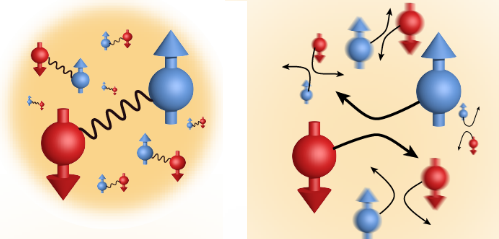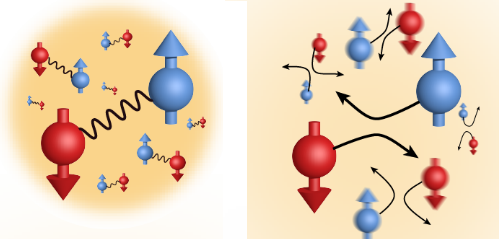Making Contact with Strongly Interacting Fermions
The electrons in a superconductor and the nucleons inside a nucleus are both examples of strongly interacting fermions. One of the open questions about these “Fermi gas” systems is how their properties are affected by particles pairing up. Two new experiments using Fermi gases of cold atoms have now tracked correlations between atom pairs. The results show that at the superfluid transition temperature, pair correlations ramp up abruptly, rather than gradually as predicted by some theories.
Researchers often utilize cold atoms to study quantum systems, as the atomic interactions can be tuned. By increasing the interaction strength between fermionic atoms, experiments can explore the “unitary” limit, where the atomic behavior is expected to reveal universal features of interacting fermions that could connect our understanding of superconductivity to that of Bose-Einstein condensation.
In one experiment, a group led by Chris Vale of Swinburne University of Technology in Australia generated a unitary Fermi gas of lithium-6 atoms and measured the momentum imparted to the atoms from a pair of crossed laser beams. From these data, the team extracted the contact parameter, which gives the likelihood of two atoms being very close to each other. They found that the contact parameter increased by 15% as they lowered the temperature to the superfluid transition point.
Another team led by Martin Zwierlein from the Massachusetts Institute of Technology, Cambridge, obtained a similar result. They placed their lithium-6 atoms in a uniform box potential, thus avoiding density variations that have complicated previous cold-atom studies. To determine the contact parameter, they relied on counting the number of atomic transitions triggered by a variable-frequency radio pulse fired into the gas.
Theoretical attempts to calculate the temperature evolution of the contact parameter have yielded very different predictions that depend on the model for interacting fermions. The sudden change in the contact parameter observed at the superfluid transition temperature suggests that fermion pairs quickly break up as a superfluid warms up and turns into a normal fluid. This interpretation would argue against certain models that predict pairing occurs at temperatures above the superfluid transition.
This research is published in Physical Review Letters.
–Michael Schirber
Michael Schirber is a Corresponding Editor for Physics based in Lyon, France.





